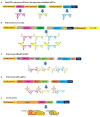Multiplex Genome-Editing Technologies for Revolutionizing Plant Biology and Crop Improvement
- PMID: 34691102
- PMCID: PMC8526792
- DOI: 10.3389/fpls.2021.721203
Multiplex Genome-Editing Technologies for Revolutionizing Plant Biology and Crop Improvement
Abstract
Multiplex genome-editing (MGE) technologies are recently developed versatile bioengineering tools for modifying two or more specific DNA loci in a genome with high precision. These genome-editing tools have greatly increased the feasibility of introducing desired changes at multiple nucleotide levels into a target genome. In particular, clustered regularly interspaced short palindromic repeats (CRISPR)/CRISPR-associated protein (Cas) [CRISPR/Cas] system-based MGE tools allow the simultaneous generation of direct mutations precisely at multiple loci in a gene or multiple genes. MGE is enhancing the field of plant molecular biology and providing capabilities for revolutionizing modern crop-breeding methods as it was virtually impossible to edit genomes so precisely at the single base-pair level with prior genome-editing tools, such as zinc-finger nucleases (ZFNs) and transcription activator-like effector nucleases (TALENs). Recently, researchers have not only started using MGE tools to advance genome-editing applications in certain plant science fields but also have attempted to decipher and answer basic questions related to plant biology. In this review, we discuss the current progress that has been made toward the development and utilization of MGE tools with an emphasis on the improvements in plant biology after the discovery of CRISPR/Cas9. Furthermore, the most recent advancements involving CRISPR/Cas applications for editing multiple loci or genes are described. Finally, insights into the strengths and importance of MGE technology in advancing crop-improvement programs are presented.
Keywords: CRISPR/Cas12; CRISPR/Cas9; crop improvement; multiplex genome editing; plant science.
Copyright © 2021 Abdelrahman, Wei, Rohila and Zhao.
Conflict of interest statement
The authors declare that the research was conducted in the absence of any commercial or financial relationships that could be construed as a potential conflict of interest.
Figures


Similar articles
-
Emerging Genome Engineering Tools in Crop Research and Breeding.Methods Mol Biol. 2020;2072:165-181. doi: 10.1007/978-1-4939-9865-4_14. Methods Mol Biol. 2020. PMID: 31541446
-
CRISPR/Cas9: an advanced tool for editing plant genomes.Transgenic Res. 2016 Oct;25(5):561-73. doi: 10.1007/s11248-016-9953-5. Epub 2016 Mar 24. Transgenic Res. 2016. PMID: 27012546 Review.
-
A Revolution toward Gene-Editing Technology and Its Application to Crop Improvement.Int J Mol Sci. 2020 Aug 7;21(16):5665. doi: 10.3390/ijms21165665. Int J Mol Sci. 2020. PMID: 32784649 Free PMC article. Review.
-
The era of editing plant genomes using CRISPR/Cas: A critical appraisal.J Biotechnol. 2020 Dec 20;324:34-60. doi: 10.1016/j.jbiotec.2020.09.013. Epub 2020 Sep 24. J Biotechnol. 2020. PMID: 32980369 Review.
-
Modern Trends in Plant Genome Editing: An Inclusive Review of the CRISPR/Cas9 Toolbox.Int J Mol Sci. 2019 Aug 19;20(16):4045. doi: 10.3390/ijms20164045. Int J Mol Sci. 2019. PMID: 31430902 Free PMC article. Review.
Cited by
-
Efficient large fragment deletion in plants: double pairs of sgRNAs are better than dual sgRNAs.Hortic Res. 2023 Aug 22;10(10):uhad168. doi: 10.1093/hr/uhad168. eCollection 2023 Oct. Hortic Res. 2023. PMID: 37841500 Free PMC article. No abstract available.
-
Complexity Meets Risk-The Next Generation of Genome-Edited Plants Challenges Established Concepts for Environmental Risk Assessment in the EU.Plants (Basel). 2025 Jun 5;14(11):1723. doi: 10.3390/plants14111723. Plants (Basel). 2025. PMID: 40508397 Free PMC article. Review.
-
Gene therapy for CNS disorders: modalities, delivery and translational challenges.Nat Rev Neurosci. 2024 Aug;25(8):553-572. doi: 10.1038/s41583-024-00829-7. Epub 2024 Jun 19. Nat Rev Neurosci. 2024. PMID: 38898231 Review.
-
The genetic orchestra of salicylic acid in plant resilience to climate change induced abiotic stress: critical review.Stress Biol. 2024 Jun 17;4(1):31. doi: 10.1007/s44154-024-00160-2. Stress Biol. 2024. PMID: 38880851 Free PMC article. Review.
-
Recommendations for the Assessment of Potential Environmental Effects of Genome-Editing Applications in Plants in the EU.Plants (Basel). 2023 Apr 25;12(9):1764. doi: 10.3390/plants12091764. Plants (Basel). 2023. PMID: 37176822 Free PMC article. Review.
References
-
- Abdelrahman M., Zhao K. (2020). Genome editing and rice grain quality, in The Future of Rice Demand: Quality Beyond Productivity, eds Costa de Oliviera A., Pegoraro C., Ebeling Viana V. (Charm: Springer; ), 395–422.
Publication types
LinkOut - more resources
Full Text Sources

